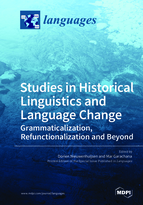Studies in Historical Linguistics and Language Change. Grammaticalization, Refunctionalization and Beyond
A special issue of Languages (ISSN 2226-471X).
Deadline for manuscript submissions: closed (1 October 2018) | Viewed by 29787
Special Issue Editors
Interests: historical linguistics; Spanish syntax; language variation and change in modern Spanish of Spain and Spanish America
Interests: historical linguistics; Spanish syntax; language variation and change in modern Spanish of Spain and Spanish America
Special Issue Information
Dear Colleagues,
This Special Issue examines the usefulness of a particular set of concepts and notions and their applicability to specific morphosyntactic changes in Spanish. The concepts we are referring to were proposed in the past 30 years in order to explain instances of language change for which grammaticalization theory could not provide a proper and satisfactory description. In his well-known and much-debated article of 1990, Lass launched the notion of exaptation, i.e. "the opportunistic co-optation of a feature whose origin is unrelated or only marginally related to its later use". A decade later, connecting with Lass' original idea, Pountain (2000) coined the term capitalization, to refer to "the historical process by which a linguistic feature which already exists in a language comes to be substantially exploited for wider purposes". Subsequently, Smith (2011) introduced the notions of refunctionalization and adfunctionalization in order to distinguish between cases of language change in which an original function was lost and those in which a new function was added to the original one. This Special Issue aims to make a contribution to the large number of studies that, over the years, have reviewed and explored the above-cited proposals and, at the same time, intends to enhance our knowledge of the evolution of the Spanish language.
Therefore, we welcome papers that address instances of language change in Spanish and discuss these changes in the light of the previously mentioned concepts.
Dr. Dorien Nieuwenhuijsen
Dr. Mar Garachana
Guest Editors
Manuscript Submission Information
Manuscripts should be submitted online at www.mdpi.com by registering and logging in to this website. Once you are registered, click here to go to the submission form. Manuscripts can be submitted until the deadline. All submissions that pass pre-check are peer-reviewed. Accepted papers will be published continuously in the journal (as soon as accepted) and will be listed together on the special issue website. Research articles, review articles as well as short communications are invited. For planned papers, a title and short abstract (about 100 words) can be sent to the Editorial Office for announcement on this website.
Submitted manuscripts should not have been published previously, nor be under consideration for publication elsewhere (except conference proceedings papers). All manuscripts are thoroughly refereed through a double-blind peer-review process. A guide for authors and other relevant information for submission of manuscripts is available on the Instructions for Authors page. Languages is an international peer-reviewed open access monthly journal published by MDPI.
Please visit the Instructions for Authors page before submitting a manuscript. The Article Processing Charge (APC) for publication in this open access journal is 1400 CHF (Swiss Francs). Submitted papers should be well formatted and use good English. Authors may use MDPI's English editing service prior to publication or during author revisions.
Keywords
- Spanish
- Latin
- language change
- refunctionalization
- grammaticalization







